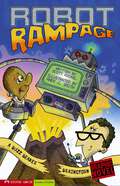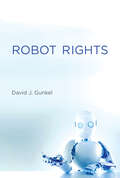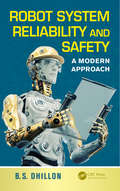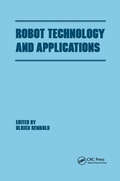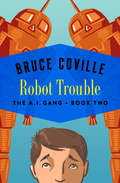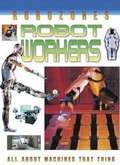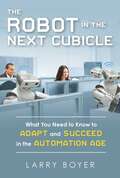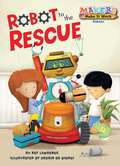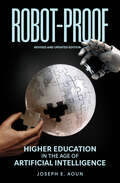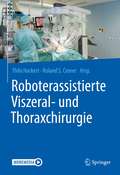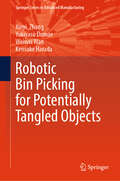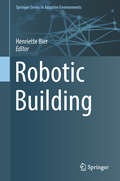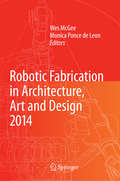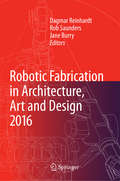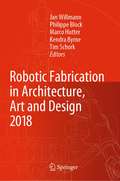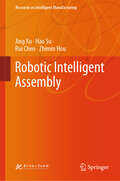- Table View
- List View
Robot Rampage: A Buzz Beaker Brainstorm (A Buzz Beaker Brainstorm)
by Scott NickelA robot built for the school science fair goes haywire, and Jimmy comes up with a plan to stop it. Written in graphic-novel format.
Robot Rebellion (Astrid the Astronaut #4)
by Rie NealThis is the fourth book in the Astrid the Astronaut chapter book series about a young girl determined to be the first hard-of-hearing astronaut in space!When Astrid and the rest of the Shooting Stars find out that their teacher, Ms. Ruiz, is about to celebrate a big birthday, they band together to create the perfect gift. Her big day happens to be the same as the upcoming robotics competition and they decide to do something there. With the help of Astrid&’s big sister, Stella, they program their robot to do a fun dance and give Ms. Ruiz a sweet surprise. But on the day of the competition, the data for the Shooting Stars robot somehow gets mixed up with another one! Will their fun present end up being a major malfunction?
Robot Rights (The\mit Press Ser.)
by David J. GunkelA provocative attempt to think about what was previously considered unthinkable: a serious philosophical case for the rights of robots.We are in the midst of a robot invasion, as devices of different configurations and capabilities slowly but surely come to take up increasingly important positions in everyday social reality—self-driving vehicles, recommendation algorithms, machine learning decision making systems, and social robots of various forms and functions. Although considerable attention has already been devoted to the subject of robots and responsibility, the question concerning the social status of these artifacts has been largely overlooked. In this book, David Gunkel offers a provocative attempt to think about what has been previously regarded as unthinkable: whether and to what extent robots and other technological artifacts of our own making can and should have any claim to moral and legal standing.In his analysis, Gunkel invokes the philosophical distinction (developed by David Hume) between “is” and “ought” in order to evaluate and analyze the different arguments regarding the question of robot rights. In the course of his examination, Gunkel finds that none of the existing positions or proposals hold up under scrutiny. In response to this, he then offers an innovative alternative proposal that effectively flips the script on the is/ought problem by introducing another, altogether different way to conceptualize the social situation of robots and the opportunities and challenges they present to existing moral and legal systems.
Robot Rules: Regulating Artificial Intelligence In The 21st Century
by Jacob TurnerThis book explains why AI is unique, what legal and ethical problems it could cause, and how we can address them. It argues that AI is unlike is any other previous technology, owing to its ability to take decisions independently and unpredictably. This gives rise to three issues: responsibility—who is liable if AI causes harm; rights—the disputed moral and pragmatic grounds for granting AI legal personality; and the ethics surrounding the decision-making of AI. The book suggests that in order to address these questions we need to develop new institutions and regulations on a cross-industry and international level. Incorporating clear explanations of complex topics, Robot Rules will appeal to a multi-disciplinary audience, from those with an interest in law, politics and philosophy, to computer programming, engineering and neuroscience.
Robot System Reliability and Safety: A Modern Approach
by B.S. DhillonWritten by a well-known expert in reliability engineering, this book presents up-to-date information on robot reliability, safety, and related areas in a single volume, eliminating the need to consult diverse sources. It covers fundamental mathematical concepts and reliability and safety basics for readers without prior knowledge of the subject. The book describes useful techniques for analyzing the reliability and safety of robot systems and includes examples with solutions, numerous problems, and extensive references.
Robot Takeover: 100 Iconic Robots of Myth, Popular Culture & Real Life
by Ana MatronicIn the not too distant future, mankind faces the possibility of being overthrown by its own creations.In Robot Takeover, Ana Matronic presents 100 of the most legendary robots and what makes them iconic - their creators, purpose, design and why their existence has shaken, or in some cases, comforted us. Through 100 iconic robots - from Maria in Fritz Lang's Metropolis to the Sentinels of The Matrix and beyond, via the Gunslinger (Westworld), R2-D2 (Star Wars) etc. - this is a comprehensive look at the robot phenomenon. As well as these 100 entries on specific robots, there are features on the people who invent robots, the moral issues around robot sentience, and the prevalence of robots in music, art and fashion, and more. It's the only robot book you need.With fighters, seducers and psychos in their ranks, it's best you get ready for the robot revolution. Know your enemy...
Robot Teams: From Diversity to Polymorphism
by Tucker Balch Lynne E. ParkerThis is a comprehensive volume on robot teams that will be the standard reference on multi-robot systems. The volume provides not only the essentials of multi-agent robotics theory but also descriptions of exemplary implemented systems demonstrating the key concepts of multi-robot research. Information is presented in a descriptive manner and augme
Robot Technology and Applications
by Ulrich RemboldIntroduces designers to hardware and software tools necessary for planning, laying out, and building advanced robot-based manufacturing cells surveying the available technology for creating innovative machines suitable to individual needs. Considers assembly system simulation, task-oriented programm
Robot Trouble (The A.I. Gang #2)
by Bruce CovilleA spy has infiltrated the island, and only the A.I. Gang can stop him Some days a gang of kid geniuses just can't win. As if it weren't bad enough that the A.I. Gang has Sergeant Brody's terrifying security robots crimping their activities and the mysterious Black Glove out to get them, now they've managed to get on the bad side of an international superspy who has secretly invaded Anza-bora Island. Of course, a little thing like that won't stop them from coming up with new schemes. But when Rachel talks the others into building a rocket to launch Dr. Weiskopf's singing robot, Twerpy, on a vital space mission, it turns out that the final countdown to blastoff may also be a countdown to death. This ebook features an illustrated personal history of Bruce Coville including rare images from the author's collection.
Robot Workers (Robozones)
by David JefferisEarly robotics researchers promised that one day robots would do all of our boring household tasks. Robot Workers reveals that that vision of the future is finally becoming a reality in the form of robotic vacuums and lawn mowers. But industry has seen the biggest benefit with robots now widely being used by car manufacturers to weld and paint vehicles, and in warehouses to stack and pack goods.
Robot in the Next Cubicle: What You Need to Know to Adapt and Succeed in the Automation Age
by Larry BoyerThis optimistic and useful look at the coming convergence of automation, robotics, and artificial intelligence, shows how we can take advantage of this revolution in the workplace, crafting "robot-proof jobs" and not fearing "the robocalypse." It's called the Fourth Industrial Revolution—a revolution fueled by analytics and technology—that consists of data-driven smart products, services, entertainment, and new jobs. Economist and data scientist Larry Boyer lays out the wealth of exciting possibilities this revolution brings as well as the serious concerns about its disruptive impact on the lives of average Americans. Most important, he shows readers how to navigate this sea of change, pointing to strategies that will give businesses and individuals the best chance to succeed and providing a roadmap to thriving in this new economy. Boyer describes how future workers may have to think of themselves as entrepreneurs, marketing their special talents as valuable skills that machines cannot do. This will be especially important in the coming employment climate, when full-time jobs are likely to decrease and industries move toward contract-based employment. He provides guidelines for identifying your individual talents and pursuing the training that will make you stand out. He also shows you how to promote your personal brand to give more exposure to your unique skills. Whether we like it or not, automation will soon transform the work place and employment prospects. This book will show you how to look for and take advantage of the opportunities that this revolution presents.
Robot to the Rescue: Robots (Makers Make It Work)
by Kay LawrenceTying into the popular Makers Movement, Makers Make it Work is a series of fun easy-to-read stories that focus on problem-solving and hands-on action. With bright, eye-catching art and explanatory sidebars with additional information on the topic, these books show kids how to use their hands, their heads, their creativity, and their problem-solving skills to overcome every challenge facing them. Greta has a robot—and a problem. She&’s going on a trip, but her cat has to stay home. Who will feed him? Maybe Greta can retool the robot to do the job! With the Makers Make It Work series, any kid can be a Maker! Each book also includes an activity for young makers to try themselves. (Topic: Robots)
Robot-Oriented Design
by Thomas Bock Thomas LinnerThe Cambridge Handbooks on Construction Robotics series focuses on the implementation of automation and robot technology to renew the construction industry and to arrest its declining productivity. The series is intended to give professionals, researchers, lecturers, and students basic conceptual and technical skills and implementation strategies to manage, research, or teach the implementation of advanced automation and robot-technology-based processes and technologies in construction. Currently, the implementation of modern developments in product structures (modularity and design for manufacturing), organizational strategies (just in time, just in sequence, and pulling production), and informational aspects (computer-aided design/manufacturing or computer-integrated manufacturing) are lagging because of the lack of modern integrated machine technology in construction. The Cambridge Handbooks on Construction Robotics books discuss progress in robot systems theory and demonstrate their integration using real systematic applications and projections for off-site as well as on-site building production. Robot-Oriented Design and Management introduces the design, innovation, and management methodologies that are key to the realization and implementation of the advanced concepts and technologies presented in the subsequent volumes. This book describes the efficient deployment of advanced construction and building technology. It is concerned with the coadaptation of construction products, processes, organization, and management, and with automated/robotic technology, so that the implementation of modern technology becomes easier and more efficient. It is also concerned with technology and innovation management methodologies and the generation of life cycle-oriented views related to the use of advanced technologies in construction.
Robot-Proof, revised and updated edition: Higher Education in the Age of Artificial Intelligence
by Joseph E. AounA fresh look at a “robot-proof” education in the new age of generative AI.In 2017, Robot-Proof, the first edition, foresaw the advent of the AI economy and called for a new model of higher education designed to help human beings flourish alongside smart machines. That economy has arrived. Creative tasks that, seven years ago, seemed resistant to automation can now be performed with a simple prompt. As a result, we must now learn not only to be conversant with these technologies, but also to comprehend and deploy their outputs. In this revised and updated edition, Joseph Aoun rethinks the university’s mission for a world transformed by AI, advocating for the lifelong endeavor of a “robot-proof” education. Aoun puts forth a framework for a new curriculum, humanics, which integrates technological, data, and human literacies in an experiential setting, and he renews the call for universities to embrace lifelong learning through a social compact with government, employers, and learners themselves. Drawing on the latest developments and debates around generative AI, Robot-Proof is a blueprint for the university as a force for human reinvention in an era of technological change—an era in which we must constantly renegotiate the shifting boundaries between artificial intelligence and the capacities that remain uniquely human.
Robot-Proof: Higher Education in the Age of Artificial Intelligence (The\mit Press Ser.)
by Joseph E. AounHow to educate the next generation of college students to invent, to create, and to discover—filling needs that even the most sophisticated robot cannot.Driverless cars are hitting the road, powered by artificial intelligence. Robots can climb stairs, open doors, win Jeopardy, analyze stocks, work in factories, find parking spaces, advise oncologists. In the past, automation was considered a threat to low-skilled labor. Now, many high-skilled functions, including interpreting medical images, doing legal research, and analyzing data, are within the skill sets of machines. How can higher education prepare students for their professional lives when professions themselves are disappearing? In Robot-Proof, Northeastern University president Joseph Aoun proposes a way to educate the next generation of college students to invent, to create, and to discover—to fill needs in society that even the most sophisticated artificial intelligence agent cannot.A “robot-proof” education, Aoun argues, is not concerned solely with topping up students' minds with high-octane facts. Rather, it calibrates them with a creative mindset and the mental elasticity to invent, discover, or create something valuable to society—a scientific proof, a hip-hop recording, a web comic, a cure for cancer. Aoun lays out the framework for a new discipline, humanics, which builds on our innate strengths and prepares students to compete in a labor market in which smart machines work alongside human professionals. The new literacies of Aoun's humanics are data literacy, technological literacy, and human literacy. Students will need data literacy to manage the flow of big data, and technological literacy to know how their machines work, but human literacy—the humanities, communication, and design—to function as a human being. Life-long learning opportunities will support their ability to adapt to change.The only certainty about the future is change. Higher education based on the new literacies of humanics can equip students for living and working through change.
Roboter- und KI-Ethik: Eine methodische Einführung – Grundlagen der Technikethik Band 1
by Michael FunkWas ist die Ethik der Roboter? Was ist KI-Ethik? Was sind „moralische Maschinen“? Welchen Gesetzen sollen sie folgen? Haben wir die Roboter, die wir brauchen, und brauchen wir die Roboter, die wir haben?In vorliegendem Buch werden Grundlagen der Ethik im Umgang mit Robotern, Drohnen und KI allgemeinverständlich dargestellt. Hierzu zählt die Unterscheidung von Moral, Ethik und Ethos sowie deren Anwendung auf Menschen und Maschinen. Kriterien, Fehlschlüsse und Robotergesetze werden vorgestellt, wie auch in die umfassende Gegenwartsdebatte übersichtlich eingeführt. Grafiken und Beispiele bieten Orientierung in einem hochaktuellen und komplexen Feld.Als methodische Einführung richtet sich vorliegendes Buch an Ingenieurwissenschaftler*innen, Informatiker*innen und Geisteswissenschaftler*innen im Berufsalltag, aber auch an interessierte Lai*innen, die Grundlagen der Ethik kennen lernen wollen. Es bildet den ersten, in sich abgerundeten Teil der Buchreihe Grundlagen der Technikethik.Mit einem Geleitwort von Yvonne Hofstetter.
Roboterassistierte Viszeral- und Thoraxchirurgie
by Thilo Hackert Roland S. CronerDie Möglichkeiten, die die Anwendung der Robotersysteme für die wichtigsten Indikationsbereiche in der Viszeral- und Thoraxchirurgie bietet, aber auch ihre Limitationen werden fundiert und detailliert von erfahrenen Experten beschrieben: Patientenlagerung, Zugang und schrittweise Durchführung der Operationen, Ergebnisse und Vergleich mit konventionell laparoskopischen und offenen Operationen, postoperatives Management, Lernkurve der Operateure, Vor- und Nachteile der roboterassistierten Verfahren. Zahlreiche Schemata und Fotografien veranschaulichen das operative Vorgehen. In einem eigenen Kapitel sind die Angebote für Ausbildung und Training der Operateure dargestellt; abschließend wird ein Ausblick auf absehbare Weiterentwicklungen gegeben.
Robotic Assistive Technologies: Principles and Practice (Rehabilitation Science in Practice Series)
by Pedro Encarnação Albert CookThis book contains a comprehensive overview of all current uses of robots in rehabilitation. The underlying principles in each application are provided. This is followed by a critical review of the technology available, of the utilization protocols, and of user studies, outcomes, and clinical evidence, if existing. Ethical and social implications of robot use are also discussed. The reader will have an in depth view of rehabilitation robots, from principles to practice.
Robotic Bin Picking for Potentially Tangled Objects (Springer Series in Advanced Manufacturing)
by Kensuke Harada Xinyi Zhang Yukiyasu Domae Weiwei WanThis book introduces methods for bin picking in manufacturing. These methods can be used to develop unified, dexterous, and robust bin picking systems for entangled objects. The target objects include both rigid and deformable objects. Robotic bin picking is a valuable task in manufacturing, aiming to automate the assembly process by utilizing robots to pick necessary objects from disorganized bins. Previous studies have addressed various challenges related to bin picking. However, when objects with complex shapes or deformable properties are randomly placed in a bin, they tend to get entangled, making it difficult for the robot to pick up individual items. This poses challenges in perception, as the robot must be capable of distinguishing between isolated objects and potentially tangled ones in a cluttered environment. This book is of interest to students, researchers, and professionals in manufacturing industries.
Robotic Building (Springer Series in Adaptive Environments)
by Henriette BierThe first volume of the Adaptive Environments series focuses on Robotic Building, which refers to both physically built robotic environments and robotically supported building processes. Physically built robotic environments consist of reconfigurable, adaptive systems incorporating sensor-actuator mechanisms that enable buildings to interact with their users and surroundings in real-time. These require Design-to-Production and Operation chains that are numerically controlled and (partially or completely) robotically driven. From architectured materials, on- and off-site robotic production to robotic building operation augmenting everyday life, the volume examines achievements of the last decades and outlines potential future developments in Robotic Building.This book offers an overview of the developments within robotics in architecture so far, and explains the future possibilities of this field. The study of interactions between human and non-human agents at building, design, production and operation level will interest readers seeking information on architecture, design-to-robotic-production and design-to-robotic-operation.
Robotic Fabrication in Architecture, Art and Design 2014
by Wes Mcgee Monica Ponce de LeonRobotic automation has become ubiquitous in the modern manufacturing landscape, spanning an overwhelming range of processes and applications-- from small scale force-controlled grinding operations for orthopedic joints to large scale composite manufacturing of aircraft fuselages. Smart factories, seamlessly linked via industrial networks and sensing, have revolutionized mass production, allowing for intelligent, adaptive manufacturing processes across a broad spectrum of industries. Against this background, an emerging group of researchers, designers, and fabricators have begun to apply robotic technology in the pursuit of architecture, art, and design, implementing them in a range of processes and scales. Coupled with computational design tools the technology is no longer relegated to the repetitive production of the assembly line, and is instead being employed for the mass-customization of non-standard components. This radical shift in protocol has been enabled by the development of new design to production workflows and the recognition of robotic manipulators as "multi-functional" fabrication platforms, capable of being reconfigured to suit the specific needs of a process. The emerging discourse surrounding robotic fabrication seeks to question the existing norms of manufacturing and has far reaching implications for the future of how architects, artists, and designers engage with materialization processes. This book presents the proceedings of Rob|Arch2014, the second international conference on robotic fabrication in architecture, art, and design. It includes a Foreword by Sigrid Brell-Cokcan and Johannes Braumann, Association for Robots in Architecture. The work contained traverses a wide range of contemporary topics, from methodologies for incorporating dynamic material feedback into existing fabrication processes, to novel interfaces for robotic programming, to new processes for large-scale automated construction. The latent argument behind this research is that the term 'file-to-factory' must not be a reductive celebration of expediency but instead a perpetual challenge to increase the quality of feedback between design, matter, and making
Robotic Fabrication in Architecture, Art and Design 2016
by Dagmar Reinhardt Rob Saunders Jane BurryThe book presents the proceedings of Rob/Arch 2016, the third international conference on robotic fabrication in architecture, art, and design. The work contains a wide range of contemporary topics, from methodologies for incorporating dynamic material feedback into existing fabrication processes, to novel interfaces for robotic programming, to new processes for large-scale automated construction. The latent argument behind this research is that the term 'file-to-factory' must not be a reductive celebration of expediency but instead a perpetual challenge to increase the quality of feedback between design, matter, and making.
Robotic Fabrication in Architecture, Art and Design 2018: Foreword by Sigrid Brell-Çokcan and Johannes Braumann, Association for Robots in Architecture
by Philippe Block Marco Hutter Jan Willmann Kendra Byrne Tim SchorkThe book presents research from Rob|Arch 2018, the fourth international conference on robotic fabrication in architecture, art, and design. In capturing the myriad of scientific advances in robotics fabrication that are currently underway – such as collaborative design tools, computerised materials, adaptive sensing and actuation, advanced construction, on-site and cooperative robotics, machine-learning, human-machine interaction, large-scale fabrication and networked workflows, to name but a few – this compendium reveals how robotic fabrication is becoming a driver of scientific innovation, cross-disciplinary fertilization and creative capacity of an unprecedented kind.
Robotic Industrialization
by Thomas Bock Thomas Linner Bock, Thomas and Linner, ThomasIn this volume, concepts, technologies and developments in the field of building-component manufacturing - based on concrete, brick, wood and steel as building materials and on large-scale prefabrication, delivering complex, customized components and products - are introduced and discussed. Robotic industrialization refers to the transformation of parts and low-level components into higher-level components, modules and finally building systems by highly mechanized, automated, or robot-supported industrial settings in structured off-site environments. Components and modules are open building systems (in modular building product structures) that are delivered by suppliers to original equipment manufacturers such as, for example, large-scale prefabrication companies or automated/robotic on-site factories. In particular, innovative large-scale prefabrication companies have altered the building structures, manufacturing processes, and organizational structures significantly to be able to assemble in their factories high-level components and modules from Tier-1 suppliers into customized buildings by heavily utilizing robotic technology in combination with automated logistics and production lines.
Robotic Intelligent Assembly (Research on Intelligent Manufacturing)
by Jing Xu Rui Chen Hao Su Zhimin HouThis book explores peg-in-hole assembly strategies to study robotic intelligent assembly. It presents several state-of-the-art principles for peg-in-hole assembly strategies, supported by experimental evidence. In pursuit of theoretical innovation, the author summarizes their research on robotic intelligent assembly over the past decade, highlighting the limitations of model-based algorithms in complex assembly environments and the importance of data efficiency for learning-based algorithms. Each algorithm is supported by extensive experimentation and results demonstrating its effectiveness. A review of research ideas provides readers with a comprehensive understanding of the progress made in this field. This monograph is intended for undergraduate and postgraduate students interested in robotic intelligent assembly, researchers studying robotic intelligent assembly algorithms, and electronic, mechanical, and computer engineers engaged in industrial robot-assisted assembly.
